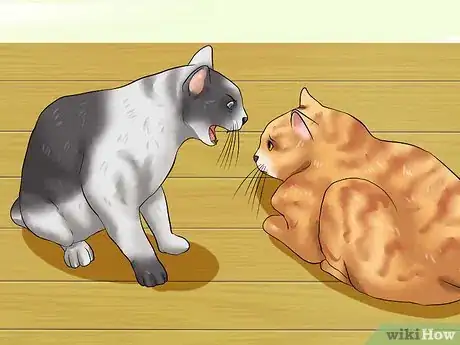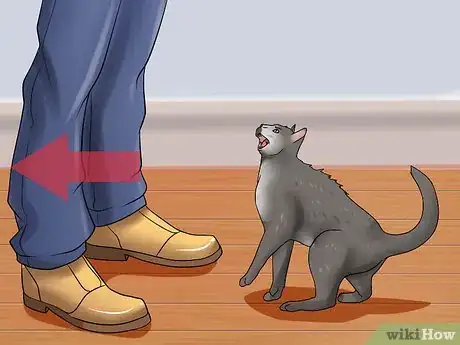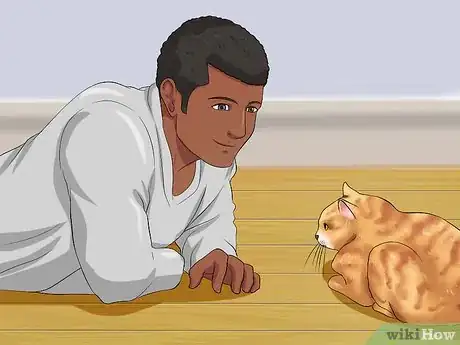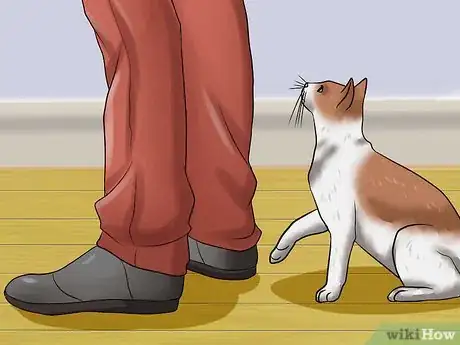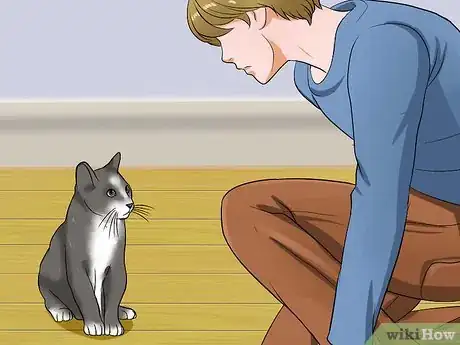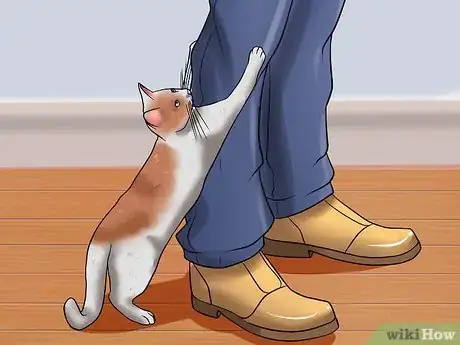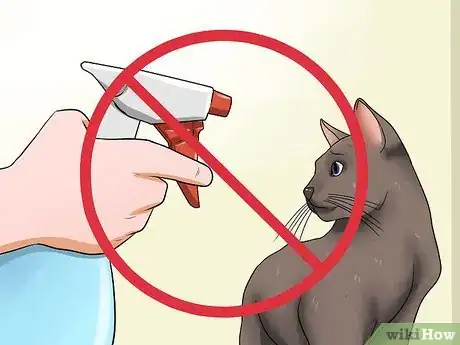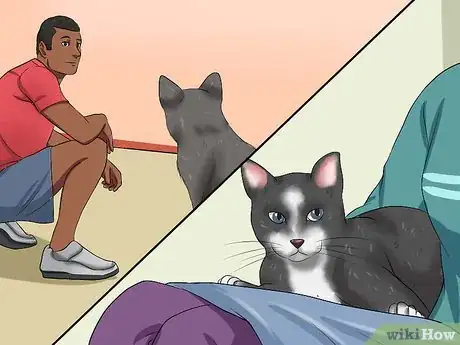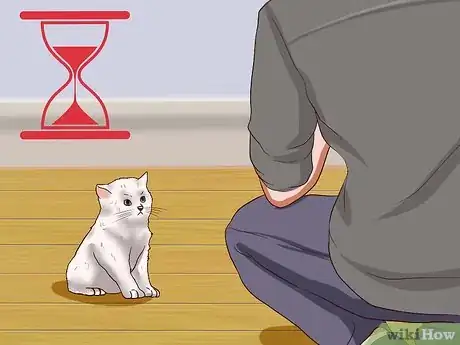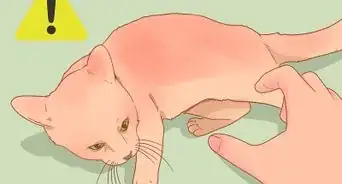This article was co-authored by Brian Bourquin, DVM. Brian Bourquin, better known as “Dr. B” to his clients, is a Veterinarian and the Owner of Boston Veterinary Clinic, a pet health care and veterinary clinic with three locations, South End/Bay Village, the Seaport, and Brookline, Massachusetts. Boston Veterinary Clinic specializes in primary veterinary care, including wellness and preventative care, sick and emergency care, soft-tissue surgery, dentistry. The clinic also provides specialty services in behavior, nutrition, and alternative pain management therapies using acupuncture, and therapeutic laser treatments. Boston Veterinary Clinic is an AAHA (American Animal Hospital Association) accredited hospital and Boston’s first Fear Free Certified Clinic. Brian has over 19 years of veterinary experience and earned his Doctor of Veterinary Medicine from Cornell University.
There are 10 references cited in this article, which can be found at the bottom of the page.
wikiHow marks an article as reader-approved once it receives enough positive feedback. In this case, several readers have written to tell us that this article was helpful to them, earning it our reader-approved status.
This article has been viewed 481,833 times.
Most anger in cats derives from fear, and aggressive behavior stems from your cat’s perception that it needs to defend itself. Placing your cat in any situation where fearful emotions arise will often result in anger. Knowing how to minimize and remove such situations is an important part of calming your angry cat and keeping it calm.
Steps
Recognizing Behaviors of an Angry Cat
-
1Consider the motivation for your cat’s anger. A cat’s primary motivation for displaying angry or aggressive behavior is fear. Cats are not as domesticated as dogs and easily revert to their wild state. This means that cats are one step away from being a wild animal still and many wild animals live in a constant state of alertness for danger, including a fear of people.[1] Top of the list for inducing fear is strangers, simply because a cat doesn't know what that person is all about until they've had time to observe and trust that the person is cat friendly. Keep in mind that the reason for your cat’s fear may not always be immediately apparent to you.[2]
- For example, your cat may begin to hiss at a toddler because the child pulled on the cat’s tail at some point when you weren’t in the room. The cat may then associate the toddler with pain in a way that causes the cat to become fearful.[3]
- A poorly socialized cat can even have a strong fear of strangers and strange surroundings.
-
2Recognize behaviors associated with fear or anger in your cat. Reading your cat's body language can help avoid conflict. It is useful to recognize both fear and aggression. However, there is an overlap between both sets of behavior, so don't get too hooked up on differentiating the two. The important thing is to recognize the cat is stressed, and stressed leads to possible attack. Be aware that a cat can turn from being calm to afraid or angry in a matter of seconds. Signs of fear or aggression include:[4] [5]
- Piloerection (hairs standing up)
- Dilated pupils
- A direct stare at you (precedes attack)
- Averting its gaze (fear)
- Whiskers stiff and drawn back
- Ears flattened against the head
- A hunched body posture
- Growling
- Drawing backs the lips and hissing.
Advertisement -
3Consider the purpose behind usual “angry” behavior. Though most of these behaviors are often thought of as signs that an angry cat is about to attack, the behaviors are more typical of a stressed and fearful cat that wants to escape the situation.[6]
-
4Look for signs of "redirected aggression". This term applies when one cat takes out its anger on another cat or person even though the source of the anger was someone or some other cat completely different. If this happens to two cats living together, it can be quite difficult to get them to get along with each other again, depending on how serious the attack was.[7]
-
5Look for biting during play. Be aware that some cats will get overexcited during play and may bite or scratch, which can be misinterpreted as aggressive behavior.
- If your cat is in a more-aggressive play mood, then you can always use dangling toys to keep your hands and fingers away from the play bites.
-
6Differentiate between fearful behavior and petting-induced aggression. Petting-induced aggression is common in some cats. The behavior doesn’t necessarily have to be at first pet. The cat may seem to enjoy the petting before suddenly becoming aggressive at the act. However, this should not be confused with anger. Reasons behind the aggression may include:[8]
- The cat using the behavior as a way of saying, "That's enough thanks.”
- The cat becoming so dozy with pleasure that it suddenly startles awake and bites in self-defense.
- This form of aggression often occurs in single kittens (only one in the litter) or hand-raised kittens. They lack socialization with other kittens, who would swipe them back if they lashed out too hard or bit too hard. However, do NOT swipe your cat back. Instead, learn to read the body language that the cat is about to flip. The cat may give a single, telltale twitch of the tail, or it may stop purring and the skin on its back may twitch. At this point, immediately stop petting the cat and stand up to tip it off your lap.[9]
Calming an Angry or Fearful Cat
-
1Take care of your own safety before all else. If your cat is angry with you or has redirected its aggression toward you, then you are a possible target for an attack, which can result in scratches or bites. However, most cats will not actually attack unless you continue provoking it after the initial warning behaviors.
- If you actually need to handle the cat, wear protective clothing and throw a blanket over the cat to help subdue the animal. However, this is only a short-term solution if it is essential to catch the cat because of potential injury. It will do nothing to endear you to the cat and will make it even less cooperative next time.
- Have a water pistol readily accessible if you live with a cat. It can be an ideal method for squirting an angry cat without having to get your hands involved. It might be enough to separate brawling cats and it can certainly be a good source of defense if the cat decides to attack you through redirected aggression.
-
2Back off. The best step you can take once you’ve recognized a behavior associated with your cat being angry or fearful is to simply back off. Step away from the cat in a way that reduces the fearful response. If possible, leave the room the cat is in, or if the cat is reacting to another person or animal, then have them leave the room. If you cannot leave the room, then make sure you back away in a manner that doesn’t block the exit since the cat may want to leave the room.[10]
- You’ll likely want to leave the cat alone for ten or twenty minutes to give it enough time to calm down.
- If the “threat” is another cat you’ve just brought home, then the desensitization process can take time, and you should keep the cats separated with only gradual introduction. You can find more information on the topic at: How to Bring a Second Cat Into the Family and Not Make Your Old Cat Upset
-
3Make yourself small. Don’t stand over or stare at the cat while it’s in an agitated state as this amplifies the threat. If you are in no immediate danger and eager to help a fearful cat feel more confident, either lie on the floor so you are less of a threat, or make yourself small by sitting down.[11]
-
4Ignore the cat. Taking your focus off the cat completely gives the cat the opportunity to assess you at its own pace to realize that you aren’t a threat.
- This includes relaxing your body language and your voice. Try talking to someone else in the room or even softly singing to yourself. Instead of creating tension, this reinforces the impression that the cat has nothing to be concerned about.[12]
-
5Provide safe places for your cat. Often, your cat may simply deal with its own fearful reactions by finding a safe place to hide. For instance, if your cat fears strangers, it will likely hide at the first sign of a doorbell or knock at the door. Consider keeping the cat’s kennel in a quiet, undisturbed room, giving the cat a place to hide until it decides it’s ready to come back out.[13]
- Cats can feel a similar sense of security from high-up places as well. Consider providing a cat tower with a high perch for the cat to hide away, especially if a new dog in the home is the source or your cat’s fearful behavior.
-
6Approach your cat slowly and with caution. After you have given your cat time and space to calm down, approach cautiously without actually touching the cat. You need to be sure that all visible signs of anger are gone, including the raised fur, hissing, and arched back. However, even with these visible signs gone, your cat may still be harboring feelings of anger and be flighty and afraid, so taking it slowly is important.
-
7Let the cat come to you. Sit or lie on the floor with treats in your hand. Let the cat sniff and explore around you. Even if the cat keeps its distance and just watches you, this builds confidence in the long term that you are not threat.
- If your cat wasn’t at all socialized to humans in the first twelve weeks of its life, then this step is crucial. Trying to make first contact will only make the cat more fearful of you. Always let the cat initiate physical contact by sniffing your and then rubbing its head against you. This transfers some of the cat’s scent onto you and makes you a bit safer in its eyes. Even then, do not reach out to the cat. Think of this as a test. You can pass the test by sitting utterly still and letting the cat feel in control. Only after it comes to you regularly should you very slowly reach out and attempt to stroke the animal.[14]
-
8Use food.[15] Shake a bag of treats or open a can of your cat’s favorite food and place it in the food bowl. Be sure that there is plenty of fresh water available since the cat may be very thirsty after such high emotions. However, don't force food or drink on your cat. The animal will know it's there when it's ready.[16]
-
9
-
10Contact your veterinarian. Illness or pain can lead to your cat exhibiting angry or aggressive behavior. If your cat begins suddenly displaying angry or fearful behaviors despite previously being docile (or if you simply haven’t made any progress with the above steps), then see your vet to rule out any medical conditions.[19]
- Common causes include high fever, tooth pain, gingivitis, abscesses, wounds, arthritis, fractures, ear problems and sprains or strains. Fur balls can sometimes trigger an angry response in a cat where the fur ball is causing colic or gastric inflammation.[20]
- If the vet determines that the problem isn’t an illness, he or she may suggest anti-anxiety medication if nothing else seems to keep your cat calm.
- If your cat exhibits the behavior in relation to a very specific event—such as car rides or even visits to the vet—then your vet may also prescribe a mild sedative for your cat. This allows you to preemptively calm the cat before subjecting it to the stressful situation. After a few instances of experiencing the situation while sedated, you may even notice that your cat becomes desensitized to the stressor.
-
11Desensitize the cat to the environmental stressor. In situations where the person or thing inducing a fearful reaction from your cat cannot actually harm the cat, then you can try desensitizing the cat to the stressor in the same way people usually get over their own phobias.[21]
- For instance, if the stressor is a person, begin by letting the cat hear the person speaking in another room until this no longer has any effect. Then step it up to having the person on the other side of the same room as the cat while completely ignoring the cat until this has no effect. Allow the person to get closer until the cat finally chooses to make contact.
- To add a counterconditioning element to desensitization training, you can include treats during the process. This not only desensitizes the cat to the stressor but begins making the cat associate the person with positive reinforcement instead.[22]
-
12Have patience. Depending on the level of socialization your cat had as a kitten, the amount of time it takes for the cat to develop trust can range anywhere from days to years.[23]
Expert Q&A
Did you know you can get expert answers for this article?
Unlock expert answers by supporting wikiHow
-
QuestionWhat should I do when my cat scratches without warning?
 Pippa Elliott, MRCVSDr. Elliott, BVMS, MRCVS is a veterinarian with over 30 years of experience in veterinary surgery and companion animal practice. She graduated from the University of Glasgow in 1987 with a degree in veterinary medicine and surgery. She has worked at the same animal clinic in her hometown for over 20 years.
Pippa Elliott, MRCVSDr. Elliott, BVMS, MRCVS is a veterinarian with over 30 years of experience in veterinary surgery and companion animal practice. She graduated from the University of Glasgow in 1987 with a degree in veterinary medicine and surgery. She has worked at the same animal clinic in her hometown for over 20 years.
Veterinarian Many cats who strike unexpectedly were poorly socialized as kittens and didn't learn to give warnings. They will often tolerate attention for a limited time and then strike out. Make a mental note of how long the cat is good for, and then always end the fuss sessions a short time before the end of the fuse is reached. If the cat is on your lap, simply stand up and tip the cat off, keeping your hands well out of the way. If necessary, cover your lap with a rug to help the tipping off process.
Many cats who strike unexpectedly were poorly socialized as kittens and didn't learn to give warnings. They will often tolerate attention for a limited time and then strike out. Make a mental note of how long the cat is good for, and then always end the fuss sessions a short time before the end of the fuse is reached. If the cat is on your lap, simply stand up and tip the cat off, keeping your hands well out of the way. If necessary, cover your lap with a rug to help the tipping off process. -
QuestionI've had my cat since he was 6 weeks old. He jumps at my feet and legs, and he also attacks my hands. What do I do to make him stop?
 Pippa Elliott, MRCVSDr. Elliott, BVMS, MRCVS is a veterinarian with over 30 years of experience in veterinary surgery and companion animal practice. She graduated from the University of Glasgow in 1987 with a degree in veterinary medicine and surgery. She has worked at the same animal clinic in her hometown for over 20 years.
Pippa Elliott, MRCVSDr. Elliott, BVMS, MRCVS is a veterinarian with over 30 years of experience in veterinary surgery and companion animal practice. She graduated from the University of Glasgow in 1987 with a degree in veterinary medicine and surgery. She has worked at the same animal clinic in her hometown for over 20 years.
Veterinarian 6 weeks is too young to leave his mother, and he would have missed out on vital socialization skills. The latter teach him that it hurts when he scratches and bites, so he learns to play with claws in. Neutering will help to a certain extent and should definitely be done. In addition, squeal and cry when he pounces on your legs. If this makes him more excited, spritz him with a water spray. Redirect his play onto toys that work at a distance from your body, such as a laser pointer or wing-on-a-string.
6 weeks is too young to leave his mother, and he would have missed out on vital socialization skills. The latter teach him that it hurts when he scratches and bites, so he learns to play with claws in. Neutering will help to a certain extent and should definitely be done. In addition, squeal and cry when he pounces on your legs. If this makes him more excited, spritz him with a water spray. Redirect his play onto toys that work at a distance from your body, such as a laser pointer or wing-on-a-string.
Warnings
- Food and water dishes work the same way. If they fight over food, set out food dishes in separate areas at more or less the same time. The bullying cat can't be in two places at once and the bullied cat will get to eat.⧼thumbs_response⧽
- If you have multiple cats, they may fight over whose litter box is whose. Some cats don't mind sharing, others do. Make sure each cat has a clean litter box Whether they allow each other to use their litter pans is up to them and how well they get along, but this one privacy concern is important to helping multiple cats get along.⧼thumbs_response⧽
- When you relocate, expect your cat to be unsettled for a while unless you move so often your cat is used to the process of moving. Just take it easy, give the cat some space, and accompany the trip with new treats and toys, so it's got something to look forward to in "moving" besides getting stuffed in a carrier and having to explore a new territory.⧼thumbs_response⧽
References
- ↑ Temple Grandin and Catherine Johnson, Making Animals Happy: How to Create the Best Life for Pets and Other Animals, p. 75, (2009), ISBN 978-0-7475-9714-8
- ↑ Why Does My Cat? Sarah Heath. Publisher: Souvenir Press
- ↑ Why Does My Cat? Sarah Heath. Publisher: Souvenir Press
- ↑ Why Does My Cat? Sarah Heath. Publisher: Souvenir Press
- ↑ Temple Grandin and Catherine Johnson, Making Animals Happy: How to Create the Best Life for Pets and Other Animals, p. 75, (2009), ISBN 978-0-7475-9714-8
- ↑ Why Does My Cat? Sarah Heath. Publisher: Souvenir Press
- ↑ Temple Grandin and Catherine Johnson, Making Animals Happy: How to Create the Best Life for Pets and Other Animals, p. 86, (2009), ISBN 978-0-7475-9714-8
- ↑ Elaine Wexler-Mitchell, The Complete Idiot's Guide to: A Healthy Cat, p. 259, (1999), ISBN 1-58245-057-9
- ↑ Feline behavior: A guide for veterinarians. Bonnie Beaver, Publisher: Saunders
- ↑ Feline behavior: A guide for veterinarians. Bonnie Beaver, Publisher: Saunders
- ↑ Feline behavior: A guide for veterinarians. Bonnie Beaver, Publisher: Saunders
- ↑ Feline behavior: A guide for veterinarians. Bonnie Beaver, Publisher: Saunders
- ↑ Why Does My Cat? Sarah Heath. Publisher: Souvenir Press
- ↑ Feline behavior: A guide for veterinarians. Bonnie Beaver, Publisher: Saunders
- ↑ Brian Bourquin, DVM. Veterinarian. Expert Interview. 20 December 2019.
- ↑ The Cat Whisperer. Clair Bessant. Publisher: Black Publishers.
- ↑ Brian Bourquin, DVM. Veterinarian. Expert Interview. 20 December 2019.
- ↑ The Cat Whisperer. Clair Bessant. Publisher: Black Publishers.
- ↑ Andrew Gardiner, A-Z of Cat Health and First Aid, p. 7, (2002), ISBN 0-285-63638-3
- ↑ Andrew Gardiner, A-Z of Cat Health and First Aid, p. 7, (2002), ISBN 0-285-63638-3
- ↑ http://www.aspca.org/pet-care/virtual-pet-behaviorist/dog-behavior/desensitization-and-counterconditioning
- ↑ http://www.aspca.org/pet-care/virtual-pet-behaviorist/dog-behavior/desensitization-and-counterconditioning
- ↑ Feline behavior: A guide for veterinarians. Bonnie Beaver, Publisher: Saunders
About This Article
To calm an angry cat, your best bet is to walk away and leave the cat for 10-20 minutes so it has time to calm down. If you're unable to leave, try getting down on the ground and making yourself appear smaller so the cat feels less threatened. You can also direct your attention away from the cat by avoiding eye contact and focusing on something else, which will give the cat time to realize that you're not a threat. For more tips from our Veterinarian co-author, like how to determine why a cat is angry in the first place, read on!



